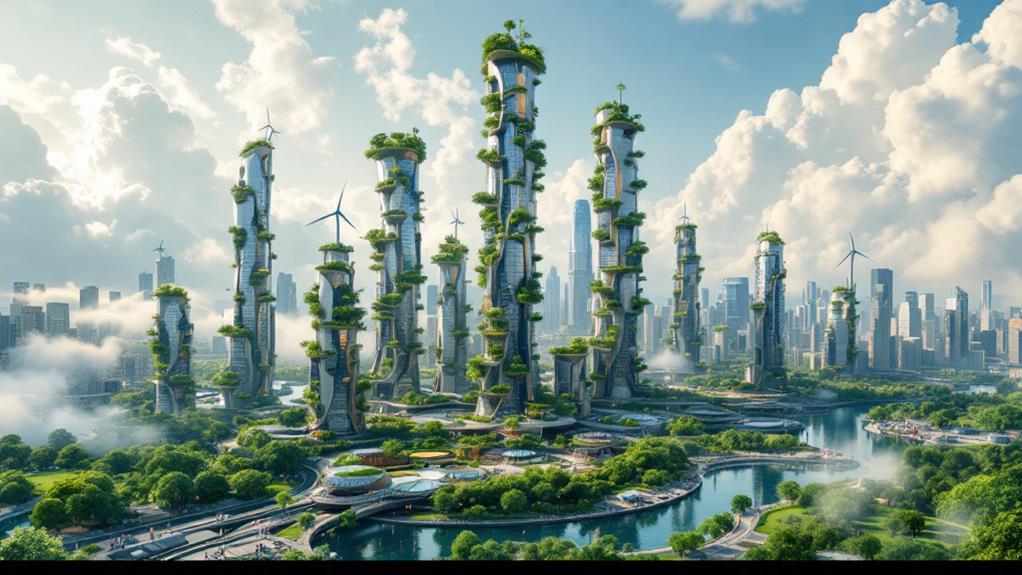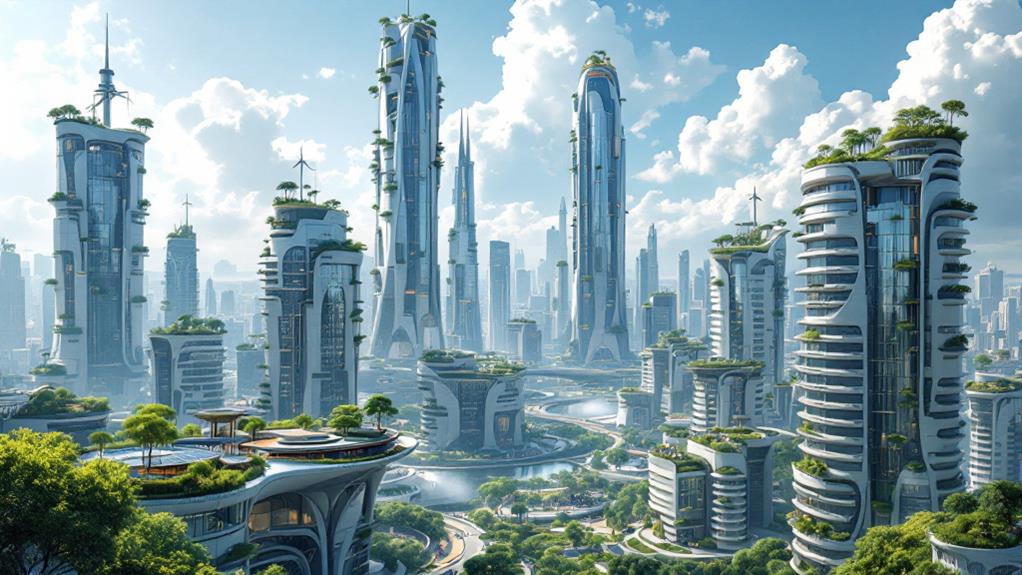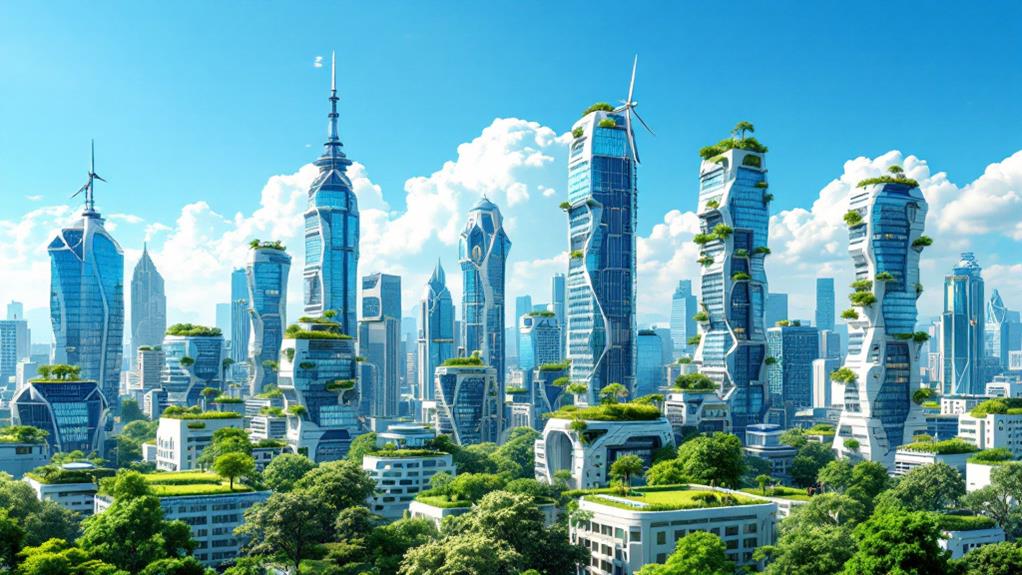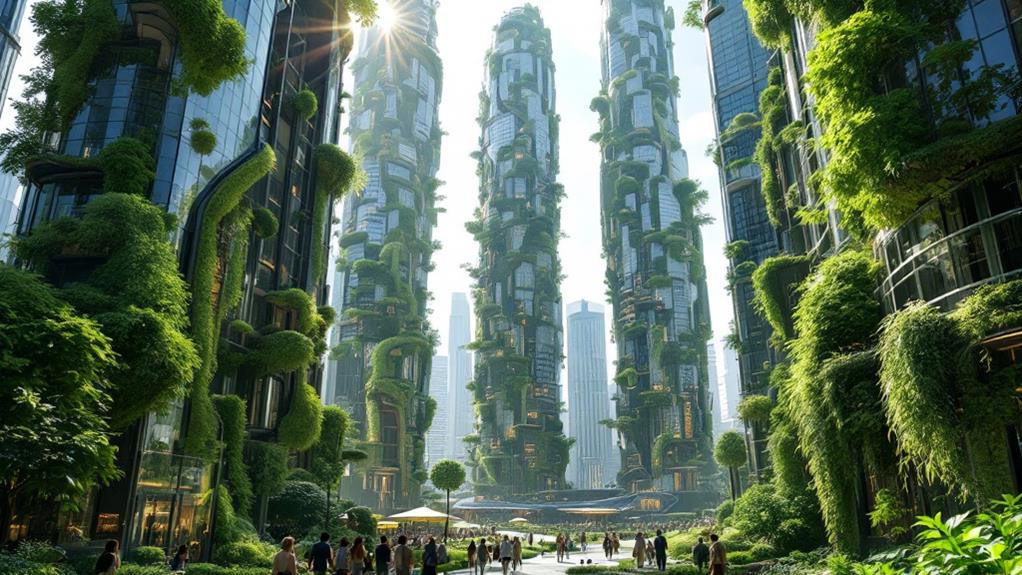How the Largest Buildings Handle Environmental Challenges

You're probably curious about how the largest buildings tackle environmental challenges. These structures often intensify the urban heat island effect by absorbing and retaining heat. Architects use sustainable materials and strategic design to mitigate this. Skyscrapers incorporate renewable energy sources like solar panels and wind turbines to cut carbon emissions. Green spaces, ventilation corridors, and bioclimatic architecture help improve air quality and cooling. By carefully arranging building orientation and selecting reflective and sustainable materials, architects optimize natural airflow and insulation. It's fascinating how these towering giants harmonize with nature—for deeper insights, there's much to uncover.
Impact on Local Climate
High-rise buildings greatly impact local climates by intensifying the Urban Heat Island (UHI) effect, often increasing temperatures by up to 5°C during the summer. This temperature rise happens because these structures use heavy materials that absorb and retain heat. As a result, you'll notice that local temperatures in areas with dense high-rise buildings tend to be higher. The urban morphology, which includes the layout and building density, plays a vital role in this scenario. It influences thermal dynamics by affecting how heat is absorbed and released.
Moreover, the presence of these towering structures alters airflow patterns, creating wind turbulence. This can lead to inconsistent cooling and sometimes even excessive heating in nearby areas, impacting the environmental quality. You'll find that the height and orientation of buildings considerably affect local thermal conditions by changing solar penetration and humidity levels. These changes can hinder effective ventilation, making urban areas less comfortable.
Understanding how high-rise buildings influence local climates helps you grasp the broader implications for urban planning. Addressing these challenges involves considering how building design and layout affect airflow and temperature, which is fundamental for improving environmental quality and enhancing urban liveability.
Thermal Analysis Techniques
To effectively address the thermal challenges posed by large buildings, you need to employ a variety of thermal analysis techniques. Start with field measurements around high-rise buildings, gathering data on temperature, air velocity, and humidity within a 150m radius. This data helps you understand local thermal conditions and how airflow patterns impact the environment. Using advanced simulation tools like Ansys-Fluent CFD and SketchUp, you can analyze the influence of building orientation on solar radiation and thermal environments. These tools reveal how the building's form and materials, such as concrete or brick, contribute to the thermal dynamics by storing heat.
Consider the geometric factors affecting thermal conditions, such as the impervious surface ratio (ISR) and green ratio (GR), which play a role in urban heat island effects. By integrating direct observations and computational simulations, you gain insights into how building massing affects airflow and thermal behavior. This understanding is essential for developing effective cooling strategies. Addressing these environmental challenges involves not just analyzing but also optimizing high-rise buildings' design to mitigate adverse thermal impacts, ensuring a balanced approach between urban development and climate resilience.
Design and Orientation

Strategize the design and orientation of buildings to transform their thermal dynamics and improve environmental performance. When planning high-rise buildings, you should consider how building orientation affects energy efficiency and thermal comfort. Properly aligning these structures can lower local temperatures by up to 5°C in summer, thanks to optimized airflow and solar penetration. This reduction is vital for improving natural ventilation and decreasing the need for mechanical cooling systems.
Your choice of materials matters too. Heavyweight materials like concrete and brick absorb solar heat, so carefully consider orientation to mitigate heat gain and increase energy efficiency. Thoughtful design strategies can also counteract the Urban Heat Island effect, where the mass and alignment of buildings trap hot air in urban canyons. By focusing on sustainable architecture, you can enhance a building's environmental performance and contribute to a healthier urban microclimate.
Incorporate ventilation paths and green spaces into your building plans to improve airflow and elevate environmental performance. These elements are essential in high-density areas, ensuring that high-rise buildings don't just stand tall, but also support a sustainable urban ecosystem.
Sustainable Architecture Practices
Someone might wonder how skyscrapers can play a role in environmental stewardship. Through sustainable architecture practices, these towering structures are transforming the urban environment. By utilizing renewable energy sources like solar, wind, and hydro power, skyscrapers considerably reduce carbon emissions. This shift not only mitigates their environmental impact but also promotes energy efficiency.
Bioclimatic architecture is key, as it focuses on designing buildings that work in harmony with natural resources. By incorporating passive solar strategies and cutting-edge façade technologies, skyscrapers improve energy efficiency and occupant comfort. The use of green roofs and walls, planted with native flora, increases local biodiversity and improves air quality, creating more sustainable green buildings. These elements provide natural insulation, further reducing energy consumption.
Moreover, green buildings cut energy consumption by over 30% compared to traditional designs. This reduction leads to economic savings and decreased greenhouse gas emissions. Emphasizing responsible sourcing of materials and applying circular economy principles minimizes waste and conserves resources. By embracing these sustainable architecture practices, you can guarantee that skyscrapers contribute positively to the urban environment, setting a precedent for future construction and environmental stewardship.
Renewable Energy Integration

In the domain of modern architecture, integrating renewable energy into high-rise buildings marks a notable stride toward sustainability. By incorporating solar panels and wind turbines, these structures greatly cut down on fossil fuel reliance. This not only leads to remarkable energy savings but also slashes carbon emissions, creating a cleaner environment. For instance, buildings equipped with solar systems can save considerably on electricity costs while achieving zero carbon emissions.
With South Africa's Green Star buildings setting a precedent by saving approximately 336 million kg of carbon emissions annually, the impact is undeniable. The creative use of bio-climatic architecture, such as phase change materials (PCMs), further improves energy efficiency. These materials adapt to solar heat gain and employ natural ventilation to maintain ideal indoor temperatures, reducing the need for artificial climate control.
Incorporating renewable energy solutions into high-rise buildings contributes to sustainable design by:
- Reducing carbon footprints through efficient energy use.
- Improving energy savings with solar panels and other technologies.
- Utilizing bio-climatic architecture to optimize natural resources.
Ultimately, these advancements in sustainable design help create a more energy-efficient and environmentally friendly urban landscape.
Urban Ventilation Solutions
Shifting our focus from renewable energy integration to urban ventilation solutions, we recognize that sustainable high-rise designs don't just rely on clean energy but also emphasize efficient airflow. Urban ventilation corridors are fundamental in alleviating heat buildup in dense areas, improving air quality around high-rise buildings. By strategically designing urban canyons, you can greatly reduce solar heat gain, increasing natural ventilation and mitigating the Urban Heat Island effect.
Careful planning is indispensable to combat wind-shadowing effects caused by tall structures, which can obstruct airflow in low-wind-speed zones. By optimizing the placement of buildings, you guarantee that ventilation is optimized, effectively cooling the urban environment.
Incorporating green spaces into urban designs isn't just aesthetic—it's a practical way to improve natural cooling processes. These areas help reduce ambient temperatures, thereby enhancing ventilation and contributing to a more comfortable urban climate.
Effective urban geometry plays a key role in creating paths for ventilation that aid cooling processes and decrease local warming. With strategic urban planning, you can design cities that breathe naturally, fostering environments that prioritize air quality and comfort in high-density settings. By prioritizing these urban ventilation solutions, you support healthier, more sustainable urban living.
Material Selection Strategies

In regard to selecting materials for large buildings, choosing wisely can greatly affect both environmental impact and energy efficiency. When considering material selection, think about how heavyweight materials like concrete and brick influence thermal dynamics. They can store heat, which contributes to the urban heat island effect. To counterbalance this, you might look into sustainable materials, such as timber, which offer lower embodied energy and fewer global warming emissions.
Incorporating cutting-edge façade technologies is another strategy. Double-skin curtain walls improve energy efficiency by providing better thermal insulation, reducing the need for artificial cooling systems. This can be particularly beneficial in high-rise developments where minimizing energy consumption is vital.
Don't forget the importance of the circular economy. By sourcing materials with this in mind, you can minimize waste and promote the reuse of materials, further lowering the environmental impact. Reflective materials in designs can also decrease heat absorption, helping to manage indoor temperatures effectively.
Consider these strategies:
- Use sustainable materials to lower embodied energy.
- Incorporate reflective materials to reduce heat absorption.
- Adopt circular economy principles to minimize waste and promote reuse.
These choices can greatly influence a building's energy profile and environmental footprint.



